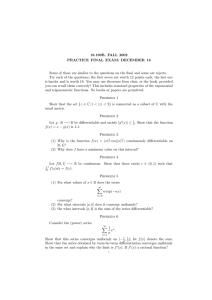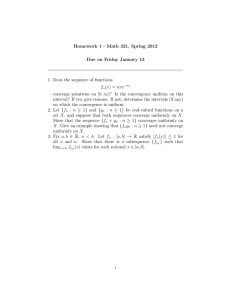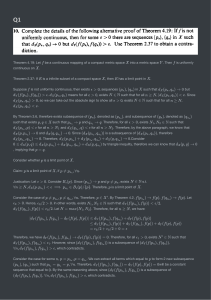18.100B/C
advertisement
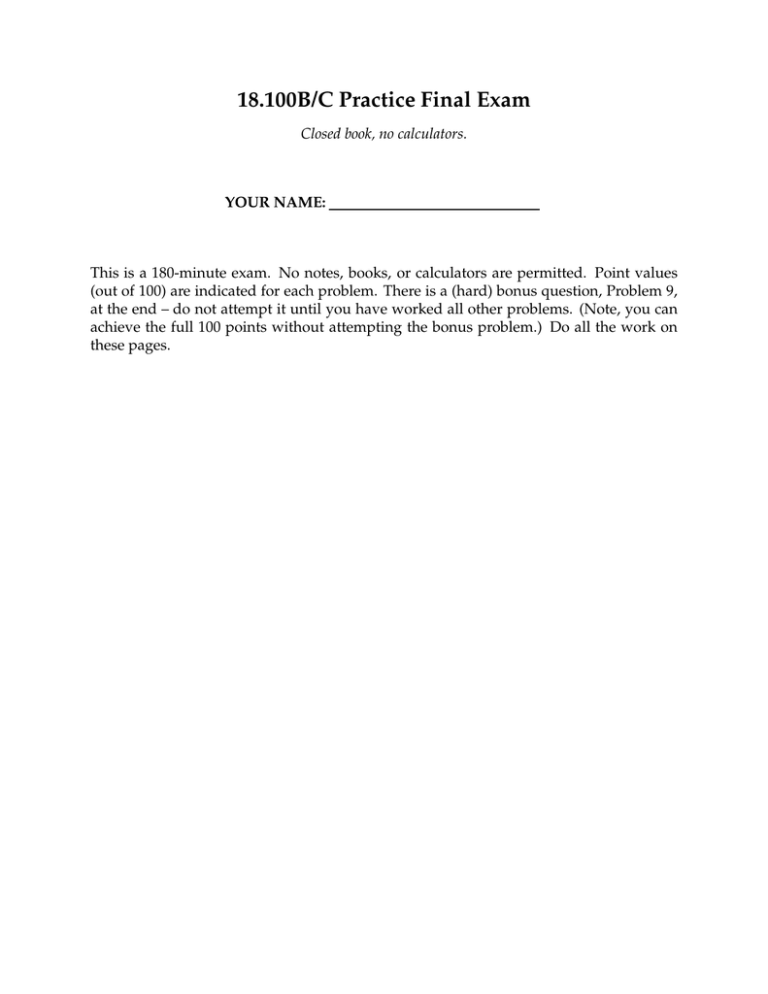
18.100B/C Practice Final Exam
Closed book, no calculators.
YOUR NAME:
This is a 180-minute exam. No notes, books, or calculators are permitted. Point values
(out of 100) are indicated for each problem. There is a (hard) bonus question, Problem 9,
at the end – do not attempt it until you have worked all other problems. (Note, you can
achieve the full 100 points without attempting the bonus problem.) Do all the work on
these pages.
Problem 1. [10 points] Suppose that x ∈ R satisfies 0 ≤ x ≤ ǫ for every ǫ > 0. Show that
x = 0, using only axioms of R as an ordered field. State the axioms you are using. (Note
that the Archimedean and least upper bound properties are not ordered field axioms.)
Problem 2. [5+5 points] Let (an ) be a sequence of positive real numbers.
(a) Suppose that the series
∞
�
an converges. Prove that
n=1
∞
�
√
an an+1 also converges.
n=1
(b) Show that the converse is also true if (an ) is monotone decreasing: i.e. in this case, if
∞
∞
�
�
√
an an+1 converges then so does
an .
n=1
n=1
Problem 3. [10 points: each part /2] For each of the following examples, either give an
example of a continuous function f on S such that f (S) = T , or explain why there can be
no such continuous function.
(a) S = (0, 1), T = (0, 1].
(b) S = (0, 1), T = (0, 1) ∪ (1, 2).
(c) S = [0, 1] ∪ [2, 3], T = {0, 1}.
(d) S = R, T = Q.
(e) S = [0, 1] × [0, 1], T = (0, 1) × (0, 1).
Problem 4. [10 points] Assume fn : E → R, E ⊆ R are uniformly continuous functions.
Assume fn converges to f uniformly. Prove that f is also uniformly continuous.
Problem 5. [10 points] Let f : X −→ Y be a continuous map between metric spaces
and let K ⊂ X be compact. Prove that f (K) ⊂ Y is compact using the definition of
compactness through open covers.
Problem 6. [10 points] Let α : [0, 1] −→ R be given by
�
x − 1 0 ≤ x < 21
α(x) =
x + 1 21 ≤ x ≤ 1
and let f (x) = 2x. Explain why the Riemann-Stieltjes integral
its value, justifying your arguments carefully.
�1
0
f dα exists and compute
Problem 7. [5+5+5 points]
(a) Let N be a subset of R. What does it mean to say “N has measure 0”? State the precise
definition.
(b) Let F (R) denote the set of all functions [0, 1] → R. Define a relation on F (R) by
saying f ∼ g iff the set of all x ∈ R where f (x) =
6 g(x) has measure 0; in words, we say “f
equals g almost everywhere.” Show that this defines an equivalence relation.
[Hint: Recall that an equivalence relation is reflexive, symmetric, and transitive.]
(c) Suppose f, g : [0, 1] → R are equal almost everywhere, and both are Riemann inte­
grable. Show that
� 1
� 1
f (x) dx =
g(x) dx.
0
0
Problem 8. [5+5+5 points]
(a) Let F = {f1 , . . . , fn } be a finite collection of uniformly continuous functions. Prove
that F is equicontinuous.
(b) Consider the infinite sequence of functions
fn (x) =
x
,
x + n1
x ∈ [0, 1], n ∈ N.
Show that each function fn is uniformly continuous.
(c) Show that the sequence of functions in (b) has no uniformly convergent subsequence.
Conclude that it is not equicontinuous.
Problem 9. [10 points] Let (pn ) be a sequence in a metric space X and p ∈ X with the
following property: Every subsequence of (pn ) itself has a subsequence which converges
to p. Show that limn→∞ pn = p.
Problem 10. [This is a bonus problem – do not attempt it until you have worked all
other problems] Let X be a compact metric space. Consider the metric space (C(X), d∞ )
of continuous R-valued functions on X equipped with the sup-metric
d∞ (f, g) = sup |f (x) − g(x)|.
x∈X
(a) Fix some point x0 ∈ X. Show that the subset K0 ⊂ C(X) of all functions f for which
f (x0 ) = 0 is closed.
(b) Let E ⊆ X be a dense subset. Let K1 ⊂ C(X) be the subset of all functions f for which
f (e) = 0 for all e ∈ E. Show that K1 is closed. Can you easily describe K1 ?
(c) Let B ⊂ C(X) denote the set of continuous functions f with supx∈X |f (x)| < 1. Show
that B is open in (C(X), d∞).
MIT OpenCourseWare
http://ocw.mit.edu
18.100B Analysis I
Fall 2010
For information about citing these materials or our Terms of Use, visit: http://ocw.mit.edu/terms.

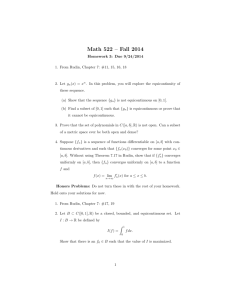
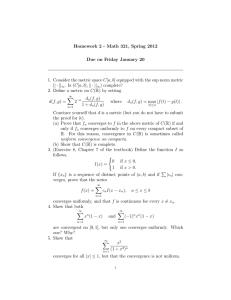
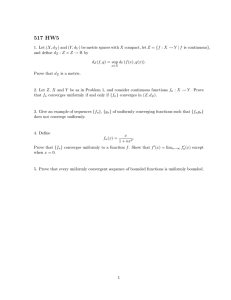
![(1) If f : [0, 1] −→ R is continuous... Z f (x)dx = f (c).](http://s2.studylib.net/store/data/010518093_1-908690675bd939e7f32dbd691b6cbb60-300x300.png)
